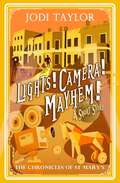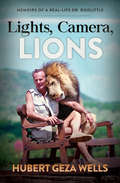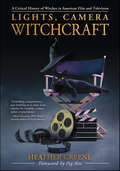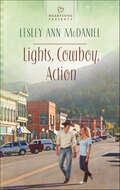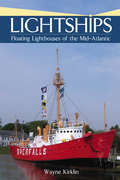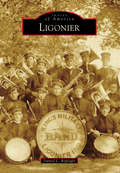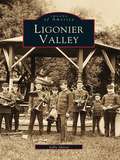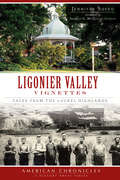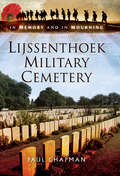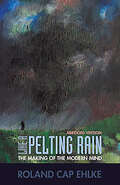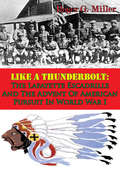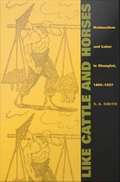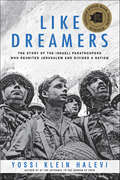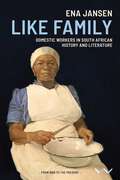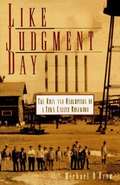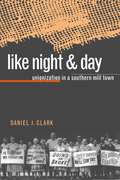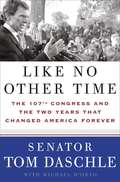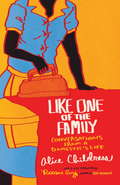- Table View
- List View
Lights! Camera! Mayhem! (Chronicles of St. Mary's)
by Jodi TaylorJodi Taylor and the disaster magnets of St Mary's return with a story of chaos and catastrophe, to wish you a very Merry Christmas.Coming to a screen near you...TEMPORA, THE TIME TRAVELLING TOURISTStarring Astrid Gustafsson as Helen of Troy - 'the face that launched a thousand ships' With Dirk Thrust as Achilles - 'demi god and hero' And the Wooden Horse as Himself - 'easily the least wooden performance from anyone participating in this particular travesty' (Dr Maxwell)Watch and weep as this epic tale unfolds...*It's drama, darling! In this year's festive tale, the nation's favourite film producer, Calvin Cutter, returns to darken the doors of St Mary's once again... Readers love Jodi Taylor: 'The Chronicles of St Mary's is one of the most enjoyable series of books I have ever read' 'Jodi Taylor is a master storyteller''I don't think I've ever laughed out loud so much reading a book''I am always gutted when I finish a Jodi Taylor book as I know I will have to wait for the next one'
Lights! Camera! Mayhem! (Chronicles of St. Mary's)
by Jodi TaylorJodi Taylor and the disaster magnets of St Mary's return with a story of chaos and catastrophe, to wish you a very Merry Christmas.Coming to a screen near you...TEMPORA, THE TIME TRAVELLING TOURISTStarring Astrid Gustafsson as Helen of Troy - 'the face that launched a thousand ships' With Dirk Thrust as Achilles - 'demi god and hero' And the Wooden Horse as Himself - 'easily the least wooden performance from anyone participating in this particular travesty' (Dr Maxwell)Watch and weep as this epic tale unfolds...*It's drama, darling! In this year's festive tale, the nation's favourite film producer, Calvin Cutter, returns to darken the doors of St Mary's once again... Readers love Jodi Taylor: 'The Chronicles of St Mary's is one of the most enjoyable series of books I have ever read' 'Jodi Taylor is a master storyteller''I don't think I've ever laughed out loud so much reading a book''I am always gutted when I finish a Jodi Taylor book as I know I will have to wait for the next one'
Lights, Camera, Lions: Memoirs of a Real-Life Dr. Doolittle
by Hubert Geza WellsA unique and entertaining memoir of training and working with animal actors. Lights, Camera, Lions tells the remarkable story of Hungarian Hubert Geza Wells, who defects to America during the communist era and goes on to make a name for himself as one of the most sought-after animal trainers in Hollywood. With tales from his long career, which included filming on five continents and working on over a hundred films including Out of Africa and Born Free, his hair-raising memoir (pun intended) also provides insight into training animals that has never been revealed before.
Lights, Camera, Witchcraft: A Critical History of Witches in American Film and Television
by Heather GreeneFollow the Witch Through Decades of American EntertainmentDeviant mistress of the dark arts. Goddess worshipper dancing in the moonlight. Crystal-wielding bookworm with a black hat and broom. We recognize the witch because no industry has been quite so influential in shaping our vision of her as Hollywood. This comprehensive book delves into the fascinating history of witchcraft and witches in American film and television.From Joan the Woman and The Wizard of Oz to Carrie and Charmed, author and film scholar Heather Greene explores how these movies and TV shows helped influence the public image of the witch and profoundly affected how women negotiate their power in a patriarchal society. Greene presents more than two hundred examples spanning silent reels to present-day blockbusters. As you travel through each decade, you'll discover compelling insights into the intersection of entertainment, critical theory, gender studies, and spirituality.
Lights, Cowboy, Action
by Lesley Ann McDanielMatchmaking is not in Courtney’s job descriptionAs assistant to a famous actress, Courtney is used to fulfilling ridiculous requests. Then her boss demands a date with handsome cowboy Adam Greene while on location in Montana. Delivering up Adam just doesn’t seem right. Especially since Courtney’s got her eye on him, too.Adam’s not interested in high-maintenance actresses. But he can’t deny his attraction to sweet, fresh-faced Courtney. How can a small-town guy compete with glitz and glamour? Leave it to a cowboy to wrangle himself a Hollywood ending....
Lightships, Lighthouses, and Lifeboat Stations: A Memoir and History
by Bernie Webber"Lightships, Lighthouses and Lifeboat Stations" is part history book, part memoir, written by Bernie Webber, recipient of the Coast Guard's highest award, the Gold Life-saving Medal, and hero of the Disney movie The Finest Hours. While the public will recognize Webber's name from the movie and the bestselling book by the same name, few people know that during his lengthy Coast Guard career he served on lightships (ships anchored in dangerous areas to warn other vessels of hazards) in addition to lifeboat stations (small boat rescue stations) and lighthouses. Webber poses the following question: "How did the lightship men cope with the isolation, constant loneliness, boredom, fear, or just sheer terror? All were part of life on board a lightship. Rough seas tossed the ship about, rearing up and down the anchor chain. This was a world of isolation, noise from operating machinery, and blasts from the powerful foghorn that went on for hours, sometimes days, at a time." Webber answers that question in this book, drawing on a combination of personal experience and meticulous historical research. Discussions of men going mad, lightships being run down by larger ships, anchor chains breaking, and lightships cast upon shoals are offset with humorous stories and the author's reflections on his best days at sea. Webber also explains some of the heroic actions of a few lightship men over the years, and points out that they received no recognition at the time. The isolation these men faced was intense, but they learned to make do with what they had. Fourteen historic photos are included, as well as a Foreword by Michael Tougias.
Lightships: Floating Lighthouses of the Mid-Atlantic
by Wayne KirklinLight boats, light vessels, lightships--before radar, depth-finders and satellite-guided navigation, mariners relied on floating lighthouses that lingered offshore as warning beacons in perilous waters.Moored near shifting shoals and treacherous reefs, lightships remained on station during all weather conditions and played a vital role in keeping America's waterways safe for navigation. From 1820 to 1985, light vessels warned of treacherous seas and pointed the way to safe harbors. In Lightships, author Wayne Kirklin chronicles the eighty-five ships that protected the mid-Atlanticcoast and the heyday of these special craft. From New York Harbor to the southernmost edge of North Carolina's notorious Cape Fear, Kirklin details the unsung role this fleet played in keeping America's merchant marines safe. Read Lightships to discovera forgotten but vital element of American maritime history
Ligonier (Images of America)
by Daniel L. ReplogleIsaac Cavin, of Ligonier, Pennsylvania, traveled to Indiana in 1830. He returned home and married Elizabeth Marker in 1834, and they traveled together to northern Indiana. In May 1835, he planned a new town and named it Ligonier. He built his home a few miles north of town and lived there for 52 years. The next big players were two German Jewish peddlers, Solomon Mier and Frederick William Straus, who traveled to the United States and settled in Indiana. After training with their uncle, they moved to Ligonier around 1854 because they were told the railroad would be coming to Ligonier and that it might be a good place to start up a business. The suggestion led to some wonderful times for Ligonier. Straus developed one of his businesses into the largest farm brokerage firm in the United States, and Mier developed one of his businesses into one of the largest farmland dealers in the Midwest. Images of America: Ligonier explores one of the most unusual small towns in the United States.
Ligonier Valley
by Sally ShireyNestled in the hills of western Pennsylvania, the Ligonier Valley has always had an air of mystery about it. The small towns and rolling countryside bear little witness to all that has occurred here. A fort was built but decayed and disappeared before being reconstructed recently. Many people have made significant contributions to the town and beyond, although time has lost many of their stories. The valley became an early industrial center with the growth of lumbering, mining, and iron production until the best resources were spent and these industries dwindled. Using hundreds of rare photographs, author Sally Shirey tells the story of this beautiful, historic area. In Ligonier Valley, readers can see the valley as it stood many years ago. After making the steep descent of Laurel Mountain, many pioneers were content to stay and build their lives in the valley. In 1758, the army of Gen. John Forbes erected Fort Ligonier. John Ramsey laid out the town of Ligonier around a public square called the Diamond. The influx of people, thanks to the Ligonier Valley Rail Road, gave rise to the hospitality industry in the valley. The Hotel Breniser, Ligonier Springs Hotel, and Kissell Springs Hotel were among those that served tourists and residents alike. Idlewild Park, dating from the 1870s, remains one of America's most beautiful amusement parks today. Reconstructed Fort Ligonier has been named to the National Register of Historic Places.
Ligonier Valley Vignettes: Tales from the Laurel Highlands (American Chronicles)
by Jennifer SopkoSecluded between Laurel Mountain and Chestnut Ridge, the Ligonier Valley has been the mountain playground of western Pennsylvania since the nineteenth century. Yet this picturesque retreat was at the tumultuous center of history--during the French and Indian War, Fort Ligonier was key to the British strategy, and in the late nineteenth century, the Ligonier Valley Rail Road helped transform the industry of the region. Author Jennifer Sopko traces the story of the valley and its residents through a series of fascinating vignettes. From the earliest histories to nostalgic reminiscences of the Ligonier Opera House, socials at the Valley Dairy ice cream parlor and bygone days at Idlewild Park, Sopko captures the history and spirit of the Ligonier Valley and its communities.
Lijssenthoek Military Cemetery (In Memory and in Mourning)
by Paul ChapmanThis is a comprehensive and highly emotive volume, borne of years of intensive research and many trips to the battlefields of the Great War. It seeks to humanise the Lijssenthoek Military Cemetery, to offer the reader a chance to engage with the personal stories of the soldiers whose names have been chiseled there in stone. Poignant stories of camaraderie, tragic twists of fate and noble sacrifice have been collated in an attempt to bring home the reality of war and the true extent of its tragic cost. It is hoped that visitors to the battlefields, whether their relatives are listed within or not, will find their experience enriched by having access to this treasure trove of stories.
Like A Pelting Rain: The Making of the Modern Mind
by Roland Cap EhlkeWhen it comes to analyzing today's culture, people talk about politics, economics, and even morals. Like a Pelting Rain: The Making of the Modern Mind goes deeper and looks at the spiritual condition of Western civilization.How we arrived at where we are is the long and complex interplay of theology and culture. Understanding the trends of the times does not necessitate accepting them. God calls upon Christians to contend for the faith. The Holy Spirit is still at work, and the Gospel remains the power of God for the salvation of all who believe!
Like A Thunderbolt: The Lafayette Escadrille And The Advent Of American Pursuit In World War I [Illustrated Edition]
by Roger G. MillerIncludes 29 IllustrationsThe advent of an American squadron, or "escadrille," within the French air force, the Service Aeronautique, had been far from a simple process. French leaders initially held the belief, common at the time, that the war begun in 1914 would be a short one. The potential value of American volunteers fighting for France both for propaganda purposes and for helping bring the power of the New World into the war on the side of the Allies was thus irrelevant at first. By early 1915, however, the French began to accept American volunteers and assign them to escadrilles. In early 1916, the Service Aeronautique united several of these men in an elite chasse unit, which quickly earned an enviable reputation for audacity, bravery, and élan.Success of this unit, the Lafayette Escadrille, had three consequences. First, its existence encouraged a large number of Americans, far more than needed in one escadrille, to volunteer for French aviation. These individuals, identified unofficially as members of a "Lafayette Flying Corps," served in numerous French air units. Second, the publicity surrounding the Lafayette Escadrille contributed favorable press for the Allied cause, strengthened ties between France and the U.S., and ultimately helped prepare the U.S. to participate on the Allied side of the conflict. Third, the existence of a large body of experienced American pilots provided combat veterans for the Air Service of the American Expeditionary Forces (AEF) in France when the U.S. ultimately entered the war. These veterans helped instill in the U.S. Air Service the attitudes and practices of the Service Aeronautique, an infusion especially reflected in two U.S. pursuit squadrons, the 103rd Aero Squadron, made up of Lafayette Escadrille pilots, and the 94th Aero Squadron, the most famous American combat squadron of the war.
Like Andy Warhol
by Jonathan FlatleyScholarly considerations of Andy Warhol abound, including very fine catalogues raisonné, notable biographies, and essays in various exhibition catalogues and anthologies. But nowhere is there an in-depth scholarly examination of Warhol’s oeuvre as a whole—until now. Jonathan Flatley’s Like Andy Warhol is a revelatory look at the artist’s likeness-producing practices, not only reflected in his famous Campbell’s soup cans and Marilyn Monroe silkscreens but across Warhol’s whole range of interests including movies, drag queens, boredom, and his sprawling collections. Flatley shows us that Warhol’s art is an illustration of the artist’s own talent for “liking.” He argues that there is in Warhol’s productions a utopian impulse, an attempt to imagine new, queer forms of emotional attachment and affiliation, and to transform the world into a place where these forms find a new home. Like Andy Warhol is not just the best full-length critical study of Warhol in print, it is also an instant classic of queer theory.
Like Cattle and Horses: Nationalism and Labor in Shanghai, 1895-1927
by S. A. SmithIn Like Cattle and Horses Steve Smith connects the rise of Chinese nationalism to the growth of a Chinese working class. Moving from the late nineteenth century, when foreign companies first set up factories on Chinese soil, to 1927, when the labor movement created by the Chinese Communist Party was crushed by Chiang Kai-shek, Smith uses a host of documents--journalistic accounts of strikes, memoirs by former activists, police records--to argue that a nationalist movement fueled by the effects of foreign imperialism had a far greater hold on working-class identity than did class consciousness. While the massive wave of labor protest in the 1920s was principally an expression of militant nationalism rather than of class consciousness, Smith argues, elements of a precarious class identity were in turn forged by the very discourse of nationalism. By linking work-related demands to the defense of the nation, anti-imperialist nationalism legitimized participation in strikes and sensitized workers to the fact that they were worthy of better treatment as Chinese citizens. Smith shows how the workers' refusal to be treated "like cattle and horses" (a phrase frequently used by workers to describe their condition) came from a new but powerfully felt sense of dignity. In short, nationalism enabled workers to interpret the anger they felt at their unjust treatment in the workplace in political terms and to create a link between their position as workers and their position as members of an oppressed nation. By focusing on the role of the working class, Like Cattle and Horses is one of very few studies that examines nationalism "from below," acknowledging the powerful agency of nonelite forces in promoting national identity. Like Cattle and Horses will interest historians of labor, modern China, and nationalism, as well as those engaged in the study of revolutions and revolt.
Like Dreamers: The Story of the Israeli Paratroopers Who Reunited Jerusalem and Divided a Nation
by Yossi Klein Halevi“Powerful. . . . beautifully written . . . . There is much to admire . . . especially Mr. Halevi’s skill at getting inside the hearts and minds of these seven men” —Ethan Bronner, New York TimesFollowing the lives of seven young members from the 55th Paratroopers Reserve Brigade, the unit responsible for restoring Jewish sovereignty to Jerusalem during the 1967 Six Day War, acclaimed journalist Yossi Klein Halevi reveals how this band of brothers played pivotal roles in shaping Israel’s destiny long after their historic victory. While they worked together to reunite their country in 1967, these men harbored drastically different visions for Israel’s future.One emerges at the forefront of the religious settlement movement, while another is instrumental in the 2005 unilateral withdrawal from Gaza. One becomes a driving force in the growth of Israel’s capitalist economy, while another ardently defends the socialist kibbutzim. One is a leading peace activist, while another helps create an anti-Zionist terror underground in Damascus.Featuring eight pages of black-and-white photos and maps, Like Dreamers is a nuanced, in-depth look at these diverse men and the conflicting beliefs that have helped to define modern Israel and the Middle East.“A beautifully written and sometimes heartbreaking account of these men, their families, and their nation.” —Booklist, starred review“Halevi's book is executed with imagination, narrative drive, and, above all, deep empathy for a wide variety of Israelis, and the result is a must-read for anyone with an interest in contemporary Israel and the Israeli-Palestinian conflict. —Publishers Weekly, starred review“Mr. Halevi’s masterly book brings us into [the] . . . debate and the lives of those who live it.” —Elliott Abrams, Wall Street Journal
Like Family: Domestic workers in South African history and literature
by Ena JansenAn analytic and historical perspective of literary texts to understand the position of domestic workers in South AfricaMore than a million black South African women are domestic workers. Precariously situated between urban and rural areas, rich and poor, white and black, these women are at once intimately connected and at a distant remove from the families they serve. Ena Jansen shows that domestic worker relations in South Africa were shaped by the institution of slavery, establishing social hierarchies and patterns of behavior that persist today. To support her argument, Jansen examines the representation of domestic workers in a diverse range of texts in English and Afrikaans. Authors include André Brink, JM Coetzee, Imraan Coovadia, Nadine Gordimer, Elsa Joubert, Antjie Krog, Sindiwe Magona, Kopano Matlwa, Es'kia Mphahlele, Sisonke Msimang, Zukiswa Wanner and Zoë Wicomb. Like Family is an updated version of the award-winning Soos familie (2015) and the highly-acclaimed 2016 Dutch translation, Bijna familie.
Like Judgment Day: The Ruin and Redemption of a Town Called Rosewood
by Michael D'OrsoThe 1923 destruction of the town of Rosewood, Florida, is a shocking episode in the history of American race relations. In a week of terror that followed the alleged rape of a white woman, at least six residents of the mostly black town were murdered. The terrified survivors were chased into the swamps, and their houses, churches, and stores burned. For over 60 years, the former citizens of Rosewood lived quietly with their grief and fear. Finally, through the determined efforts of Rosewood descendants, persistent journalists, and talented lawyers, the long-buried story was brought to light.
Like Night and Day: Unionization in a Southern Mill Town
by Daniel J. ClarkDaniel Clark demonstrates the dramatic impact unionization made on the lives of textile workers in Henderson, North Carolina, in the decade after World War II. Focusing on the Harriet and Henderson Cotton Mills, he shows that workers valued the Textile Workers Union of America for more than the higher wages and improved benefits it secured for them. Specifically, Clark points to the importance members placed on union-instituted grievance and arbitration procedures, which most labor historians have seen as impediments rather than improvements. From the signing of contracts in 1943 until a devastating strike fifteen years later, the union gave local workers the tools they needed to secure at least some measure of workplace autonomy and respect from their employer. Union-instituted grievance procedures were not without flaws, says Clark, but they were the linchpin of these efforts. When arbitration and grievance agreements collapsed in 1958, the result was the strike that ultimately broke the union. Based on complete access to company archives and transcripts of grievance hearings, this case study recasts our understanding of labor-management relations in the postwar South.
Like No Other
by Anna Jacobs1755. Rachel Smedling is not like the other women in her isolated Pennine village: she is taller, stronger and weaves cloth like a man. Without her, the household would fall apart, for her mother is ailing and her vicious drunkard father seems to hate her so much, he would happily offer money to any man who would wed her. When her mother dies, Rachel is at the mercy of her increasingly violent father. Her only escape is by marrying a kindly man with whom she finds happiness, if not passion, and her life begins to seem complete. Rachel's growing prosperity infuriates her father and his cronies, however, and they will stop at nothing to see her destroyed.
Like No Other
by Anna Jacobs1755. Rachel Smedling is not like the other women in her isolated Pennine village: she is taller, stronger and weaves cloth like a man. Without her, the household would fall apart, for her mother is ailing and her vicious drunkard father seems to hate her so much, he would happily offer money to any man who would wed her. When her mother dies, Rachel is at the mercy of her increasingly violent father. Her only escape is by marrying a kindly man with whom she finds happiness, if not passion, and her life begins to seem complete. Rachel's growing prosperity infuriates her father and his cronies, however, and they will stop at nothing to see her destroyed.
Like No Other
by Anna JacobsRachel Smedling is not like the other women in her isolated Pennine village: she is taller, stronger and weaves cloth like a man. Without her, the household would fall apart, for her mother is ailing and her vicious drunkard father seems to hate her so much, he would happily offer money to any man who would wed her. When her mother dies, Rachel is at the mercy of her increasingly violent father. Her only escape is by marrying a kindly man with whom she finds happiness, if not passion, and her life begins to seem complete. Rachel's growing prosperity infuriates her father and his cronies, however, and they will stop at nothing to see her destroyed.(P)2004 Isis Publishing Ltd
Like No Other Lover
by Julie Anne LongNow or Never. . . It's the last chance for Cynthia Brightly, the ton's most bewitching belle. Driven out of London by a secret scandal, she must find a grand husband at the Redmonds' house party before word of her downfall spreads all over England. Unfortunately, someone at Pennyroyal Green is already privy to the whispers of broken engagements and dueling lovers: Miles Redmond, renowned explorer and-thanks to his brother's disappearance-heir to the family's enormous fortune. Miles set his sights on Cynthia once, at a time when the ambitious beauty thought herself too good for a second son. But now he's heir apparent, relishing his control. He strikes a bargain with her: he'll keep Cynthia's steamy secrets and help her find a husband among the guests-in exchange for a single kiss. What could be the harm in a simple kiss? Cynthia is about to discover that it's enough to unleash fierce passion-and that Miles Redmond is most certainly like no other lover in the world.
Like No Other Time: The 107th Congress and the Two Years That Changed America Forever
by Tom Daschle Michael D'OrsoTom Daschle, the Majority Leader of the historic 107th Senate, presents a candid insider’s account of the workings of the U.S. government during two of the most tumultuous years in the nation’s history.The 107th Congress faced a time like no other in the life of the nation. This was the era of the first presidential election to be decided by the United States Supreme Court, the fifty-fifty Senate, the horror of September 11, the anthrax attacks on media and the government (including Daschle’s own office), the war on terrorism, corporate scandals that shook the economy, the inexorable move toward war with Iraq, and other dramatic events, all leading up to the historic midterm elections of 2002.Through it all, Senator Tom Daschle had, with the exception of the President, the most privileged view of these unfolding developments, both in front of and behind the closed doors of government. In Like No Other Time, Daschle offers a riveting account of his singular perspective on a time when the nation faced deadly and elusive external enemies and a level of domestic political contention rarely seen in American history. Senator Daschle is un-flinching in his impressions of the key political figures of our time from both parties. The result is an acutely perceptive assessment of how our government met—and sometimes did not meet—the challenges of a remarkable era.As it was during the years of the 107th Congress, the United States is once again at a critical and historic crossroads. Our choices, based on what we have learned from our recent past, will affect our future in profound ways. For Senator Daschle, the first and perhaps most important choice lies with what kind of representation and leadership we want in government. It is a choice between a political party with a core philosophical belief in the power of our collective will to confront these challenges through our government, and one dominated by a group of people who don’t like and don’t believe in government.
Like One of The Family
by Alice ChildressA new edition of Alice Childress’s classic novel about African American domestic workers, featuring a foreword by Roxane GayFirst published in Paul Robeson’s newspaper, Freedom, and composed of a series of conversations between Mildred, a black domestic, and her friend Marge, Like One of the Family is a wry, incisive portrait of working women in Harlem in the 1950’s. Rippling with satire and humor, Mildred’s outspoken accounts vividly capture her white employers’ complacency and condescension—and their startled reactions to a maid who speaks her mind and refuses to exchange dignity for pay.Upon publication the book sparked a critique of working conditions, laying the groundwork for the contemporary domestic worker movement. Although she was critically praised, Childress’s uncompromising politics and unflinching depictions of racism, classism, and sexism relegated her to the fringe of American literature. Like One of the Family has been long overlooked, but this new edition, featuring a foreword by best-selling author Roxane Gay, will introduce Childress to a new generation.
